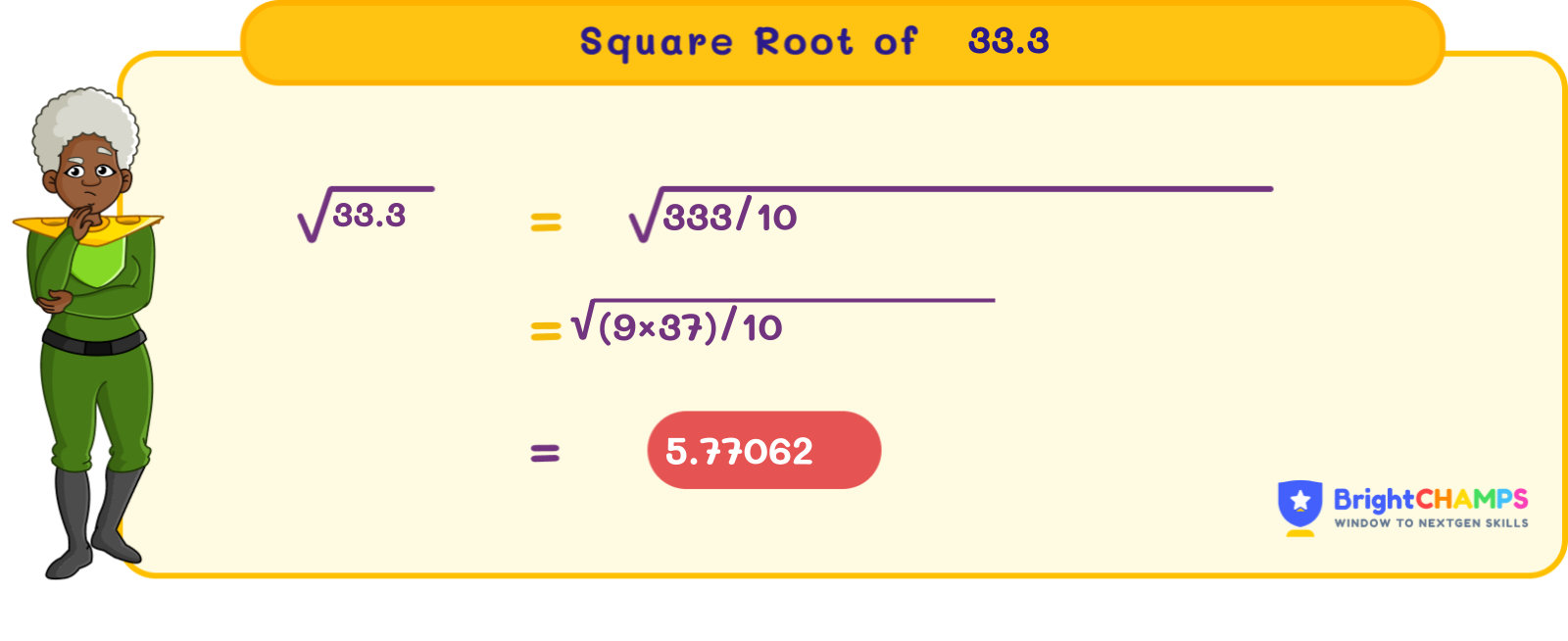![]() Table Of Contents
Table Of Contents

 100 Learners
100 LearnersLast updated on April 8th, 2025

Square Root of 33.3

If a number is multiplied by itself, the result is a square. The inverse of the square is a square root. The square root is used in various fields such as vehicle design, finance, etc. Here, we will discuss the square root of 33.3
What is the Square Root of 33.3?
The square root is the inverse of the square of a number. 33.3 is not a perfect square. The square root of 33.3 is expressed in both radical and exponential form. In the radical form, it is expressed as √33.3, whereas (33.3)¹/² in the exponential form. √33.3 ≈ 5.7717, which is an irrational number because it cannot be expressed in the form of p/q, where p and q are integers and q ≠ 0.
Finding the Square Root of 33.3
The prime factorization method is used for perfect square numbers. However, for non-perfect square numbers, the prime factorization method is not applied. Instead, methods such as the long-division method and the approximation method are used. Let us now learn these methods:
- Prime factorization method
- Long division method
- Approximation method
Square Root of 33.3 by Prime Factorization Method
The product of prime factors is the prime factorization of a number. However, since 33.3 is not a whole number, traditional prime factorization is not applicable directly. For decimal numbers, approximation methods are more suitable.
Square Root of 33.3 by Long Division Method
The long division method is particularly used for non-perfect square numbers. In this method, we should check the closest perfect square number for the given number. Let us now learn how to find the square root using the long division method, step by step.
Step 1: To begin with, consider the integer part of 33.3, which is 33. Pair 33 from right to left.
Step 2: Find a number whose square is less than or equal to 33. The number is 5, since 5 × 5 = 25.
Step 3: Subtract 25 from 33, we get a remainder of 8. Bring down two zeroes to make it 800.
Step 4: Double the quotient (5) and write it beside the divisor as 10. We need to find a digit x such that 10x × x is less than or equal to 800.
Step 5: By trial, 107 × 7 = 749.
Step 6: Subtract 749 from 800, we get 51. Bring down two more zeroes to make it 5100.
Step 7: Double the current quotient to get 114 and continue the process.
Step 8: Continue this process until the desired decimal places are reached.
So the square root of √33.3 ≈ 5.7717
Square Root of 33.3 by Approximation Method
The approximation method is another method for finding square roots. It is an easy method to find the square root of a given number. Now let us learn how to find the square root of 33.3 using the approximation method.
Step 1: Now we have to find the closest perfect square of √33.3.
The closest perfect squares are 25 (5²) and 36 (6²).
√33.3 falls between 5 and 6.
Step 2: Now we apply the formula:
(Given number - smaller perfect square) / (larger perfect square - smaller perfect square)
Using the formula, (33.3 - 25) / (36 - 25) = 8.3 / 11 ≈ 0.7545
Adding this to 5: 5 + 0.7545 = 5.7545, so the square root of 33.3 ≈ 5.7717

Common Mistakes and How to Avoid Them in the Square Root of 33.3

Square Root of 33.3 Examples

Problem 1
Can you help Max find the area of a square box if its side length is given as √33.3?

Explanation

Problem 2
A square-shaped garden measures 33.3 square feet. If each side is √33.3, what is the length of each side?

Explanation

Problem 3
Calculate √33.3 × 5.

Explanation

Problem 4
What will be the square root of (25 + 8.3)?

Explanation

Problem 5
Find the perimeter of a rectangle if its length ‘l’ is √33.3 units and the width ‘w’ is 10 units.

Explanation


FAQ on Square Root of 33.3
1.What is √33.3 in its simplest form?
2.Is 33.3 a perfect square?
3.Calculate the square of 33.3.
4.Is 33.3 a prime number?
5.What numbers is 33.3 divisible by?
Important Glossaries for the Square Root of 33.3
- Square root: A square root is the inverse operation of squaring a number. For example, if 4² = 16, then √16 = 4.
- Irrational number: An irrational number is a number that cannot be expressed as a simple fraction. It has a non-repeating, non-terminating decimal expansion.
- Principal square root: The principal square root refers to the positive square root of a number. For example, the principal square root of 16 is 4.
- Decimal: A decimal is a number expressed in the base-10 numeral system, which includes a whole number and a fractional part separated by a decimal point. For example, 33.3 is a decimal.
- Long division method: A procedure used to find the square root of non-perfect squares by dividing and averaging to reach an approximation.
Explore More algebra
 Previous to Square Root of 33.3
Previous to Square Root of 33.3


Jaskaran Singh Saluja
About the Author
Jaskaran Singh Saluja is a math wizard with nearly three years of experience as a math teacher. His expertise is in algebra, so he can make algebra classes interesting by turning tricky equations into simple puzzles.

Fun Fact
: He loves to play the quiz with kids through algebra to make kids love it.




